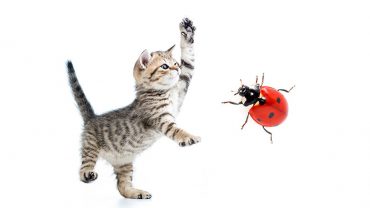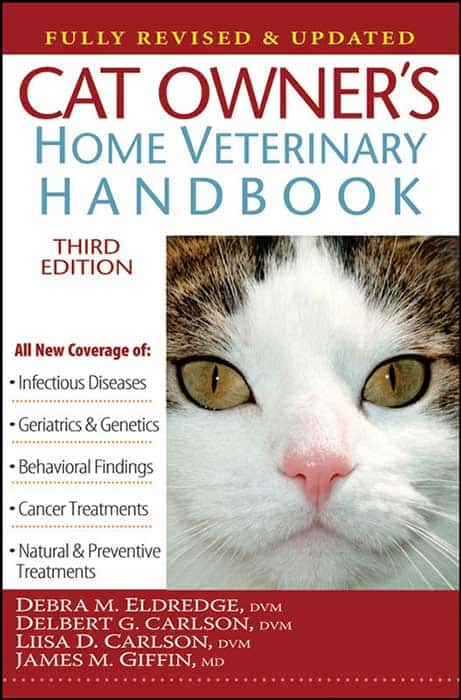It’s the instinct of most pet parents to view every insect in their backyard as potentially toxic to their pets. So, it might happen that you own a bug-eating cat and you’re wondering to yourself, can cats eat ladybugs?
Generally, ladybugs are considered harmless to cats. Unlike other colorful bugs, such as lovebugs, spiders, and fireflies, ladybugs will unlikely cause any immediate health risks for your furry, little friend.
However, there are always caveats to note when it comes to analyzing what foods your cat should eat and what it shouldn’t.
In the case of ladybirds, your immediate concern should be how to identify the bugs from among a host of similar insects.
Remember that ladybugs bear close resemblance to many insects, and your yard could be swarming with hundreds of other poisonous bugs that might easily be passed up for ladybugs.
Another thing to watch out for is the number of bugs your cat consumes. Snacking on these tiny insects may be allowed, but binging on them might raise an alarm.
Read on for more insights on the topic.
Table of Contents
Common Insects Considered Harmful To Cats
Perhaps before delve further into ladybirds, it’s important to understand the common backyard and house insects that could harm your cat.
The following is a list of these insects against their possible toxicity for felines.
1. Spiders
Generally, most small house spiders are harmless to cats. However, venomous spiders affect cats even worse than they affect humans. Examples include the Black Widows, Hobo Spiders, and Brown Recluse.
Bites from any of these spiders might cause your cat to develop localized wounds, muscle tremors, paralysis, as well as GI complications, such as nausea, vomiting, and diarrhea.
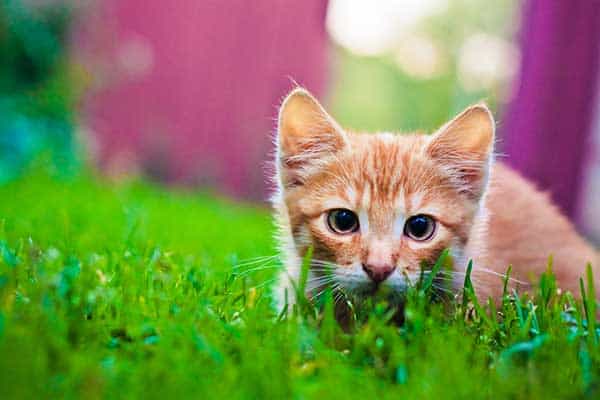
2. Stingers
Stingers, such as wasps and bees are also dangerous for cats. The venom from their stings may not necessarily kill your feline friend, but it will wreak havoc on its skin.
Bee and wasp stings might cause the cat to develop allergic reactions and experience anaphylaxis. Common remedies to these stings include anti-histamines and diphenhydramines.
3. Ants
Except for fire ants, most other ants are harmless to cats.
4. Butterflies, Caterpillars, and Moths
Most butterflies and moths will pose no risks to your cat, though some caterpillars may sting, causing skin irritation. However, these stings are largely non-toxic.
You can keep moths away by using cedar as opposed to the popular mothballs. Mothballs are highly toxic to cats, and could cause tremors, seizures, lethargy, weakness, and labored breathing.
5. Centipedes
Small house centipedes are harmless. But large ones are venomous and may hit back at your cat, causing localized reactions, fever, or lethargy.
Watch out for the Texas Redheaded Centipede and the Giant Redheaded Centipede, which are highly toxic and could be deadly.
6. Hard-bodied insects
Hard-bodied insects, such as crickets, roaches, beetles, and grasshoppers are typically non-toxic to felines.
The only problem arises when the cat ingests their exoskeleton, which could cause oral irritation and GI upset.
7. Scorpions
Scorpions may sting cats, but the stings aren’t venomous. The cat might develop vomiting and labored breathing, though these symptoms are short-lived.
8. Mosquitoes
Though cats aren’t their ideal hosts, mosquitoes can cause fatal heartworm in cats. Sadly, the condition isn’t treatable.
9. Fleas
Fleas are some of the most common parasites in cats. They cause irritation and are risk factors for anemia and tapeworm infection.
10. Ticks
Besides sucking your kitto’s blood, ticks are also vectors for disease.
11. Flies
The only danger of flies is that they could bite your cat on an infected wound, lay their eggs there to produce maggots, which only exacerbate wounds.

So, Where Does That Leave Ladybugs?
As we mentioned earlier on, your immediate concern should be how to identify a ladybug from amongst other insects.
Also known as ladybirds, or lady beetles, a ladybug is a small type of beetle that’s found all over the world. They belong to the Coccinellidae family, a unit that comprises more than 5,000 different insect species whose sizes range from 0.8 cm to 1.8 cm.
Ladybugs come in many sizes, shapes, and colors. However, most adult ladybirds may reach body lengths of 7.6–10.0 mm and are predominantly red with black spots. In the US and UK, the Seven Spotted Ladybug is the most prevalent type.
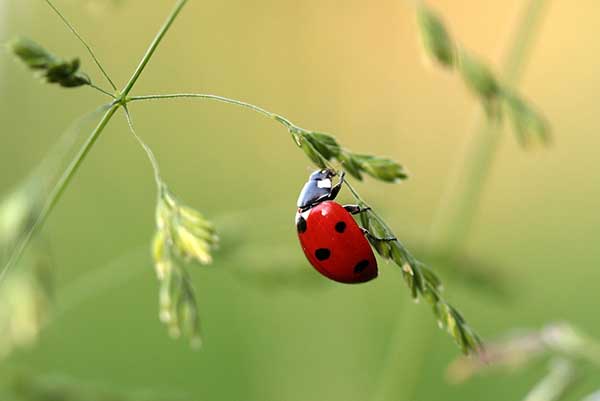
Ladybugs have six legs and are both terrestrial (able to dwell on the ground) and arboreal (can live on trees). These insects can also fly, though you won’t immediately spot their wings which are usually tucked under their dome-shaped bodies.
Contrary to popular belief, ladybugs are harmless to both humans and felines, and shouldn’t even be viewed as agricultural pests. In any case, they could be very useful to farmers, as they tend to feed on many of the crop-eating pests, such as aphids and scale insects. It’s believed that a single ladybug can devour up to 5000 aphids.
Why Are Cats Attracted To Ladybugs?
Cats are intrinsically programmed to hunt. Though they naturally prey on smaller mammals, birds, and certain reptiles, their strong prey drive kicks in immediately they spot anything moving in your house or yard.
Insects and bugs don’t comprise a significant portion of your feline’s diet, but cats will still chase after them and possibly kill them. And a cat’s curiosity doesn’t stop the moment it kills a ladybug. Once the insect is dead, your kitto will try to eat it to get the taste of this new item on the menu. And that’s how the cat might end up developing a taste for ladybugs.
Like most insects, ladybugs tend to move to warmer and brighter places during winter. You’ll find them hibernating on cracks on your walls, doors, and windows. It’s during such periods that cats prey on them the most.
Are All Ladybugs Harmless To Cats?
There are different species of ladybugs, and each one of them comes with its own toxicity levels for cats. Though the species number in their thousands, only about 300 are the most common. The most prevalent of all ladybug species is the red ladybug that features black spots.
Besides the red ladybirds, these bugs also come in yellow, brown, black, orange, pink, and numerous other color shades.
In terms of spots, a ladybug can have as few as 2 and as many as 14 spots, though the most popular ones are 2, 7, 9, 13, and 14. In fact, some ladybirds get their names from the number of spots they have, such as the red 2-spot ladybug and the yellow 14-spot ladybug.

As we already pointed out, the red ladybird is a farmer’s darling, as it feeds on crop-destroying pests and insects. But are red ladybugs poisonous to cats? And what about the orange lady beetles, are orange ladybugs poisonous to cats too?
? Yes, the red and orange ladybirds present the highest risks of toxicity to cats. What complicates the situation is that these two ladybug species also happen to be among the most prevalent. But the saving grace is that their bright colors act as warning signs, and makes it almost impossible for cat owners to miss these bugs in their houses or yards.
And how about the black and yellow ladybugs, are black ladybugs poisonous to cats? You might also be wondering, are yellow ladybugs poisonous to cats?
Black and yellow ladybugs pose milder toxicity levels compared to their orange and yellow counterparts. The least toxic ladybugs are the brown-colored ones.
Most importantly, it’s important to remember that even the ladybugs that are deemed to carry maximum risks of toxicity are still unlikely to pose any serious threats to your cat.
What Could Go Wrong If a Cat Eats Ladybugs?
What makes ladybugs somewhat toxic to cats is the fact that they release smelly yellow fluid, which they use as a defense mechanism against predators.
Besides the unsavory taste of this fluid, it could also cause certain digestive and gastrointestinal complications for your cat. The tough shells and exoskeletons of ladybugs are also known to irritate your feline’s digestive tract.
The irritation often ranges from mild to full-blown ulcerations, and may make it difficult for your cat to swallow anything. Chemical burns are quite specific to the Asian lady beetle, also known as the Harmonia axyridis.
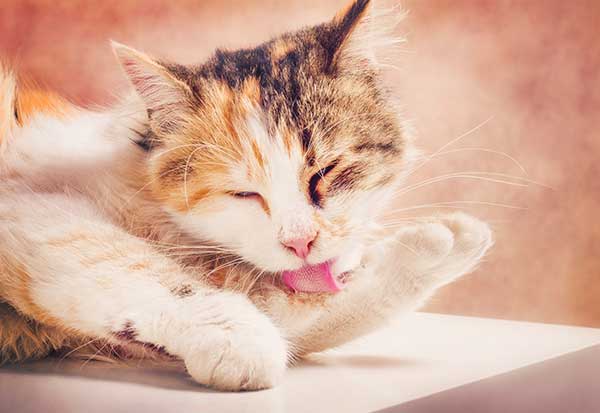
So, will a cat get sick from eating a ladybug?
Yes, but the cat will need to have eaten several ladybugs to suffer any serious side effects. One symptom to watch out for is gastrointestinal upset, which manifests in vomiting and diarrhea, constipation, and loss of appetite. In most cases, these symptoms are mild and short-lasting.
Also, you can always remedy the situation by encouraging your cat to drink a lot of water to avert possible dehydration and loss of appetite. But should the symptoms persist for more than 24 hours, then you know it’s time to take your feline to the vet’s for further examination.
It’s also worth noting that thanks to the awful smell of the fluid that ladybugs secrete, your cat is unlikely to develop a taste for these insects.
Should I Spray My Yard For Ladybugs To Protect My Cat?
Generally, ladybugs will not pose any immediate health risks for your cat. Therefore, spraying these insects isn’t a great idea.
? Remember that most insecticides and pesticides are highly toxic to cats, especially if ingested. You can only use these aerosols if your home is infested with other dangerous insects, such as spiders.
Your best bet is to go for safer ladybug extermination methods, such as manual removal. Again, it depends on the type of ladybirds that are present in your home. Naturally, the bright-colored ones tend to be the most toxic, and fortunately, the easiest to spot.
Lastly, ensure your cat doesn’t develop a taste for these insects. It’s okay if the cat finds them fun to play with, but not as a delicacy.
Conclusion
Ladybugs aren’t toxic for cats, and there’s nothing to worry about even if your feline friend munches on a few of these bugs. And due to their smelly secretions, your cat might never prey on these insects more than once in its lifetime.

